Target 5
By 2031, increase the proportion of Aboriginal and Torres Strait Islander people (age 20-24) attaining year 12 or equivalent qualification to 96%.
Nationally in 2021, 68.1% of Aboriginal and Torres Strait Islander people aged 20–24 years had attained Year 12 or equivalent qualification (figure CtG5.1).
This is an increase from 63.2% in 2016 (the baseline year).
Nationally, based on progress from the baseline, the target shows improvement but is not on track to be met. However, this assessment should be used with caution as it is based on a limited number of data points. Please refer to the How to interpret the data page for more information.
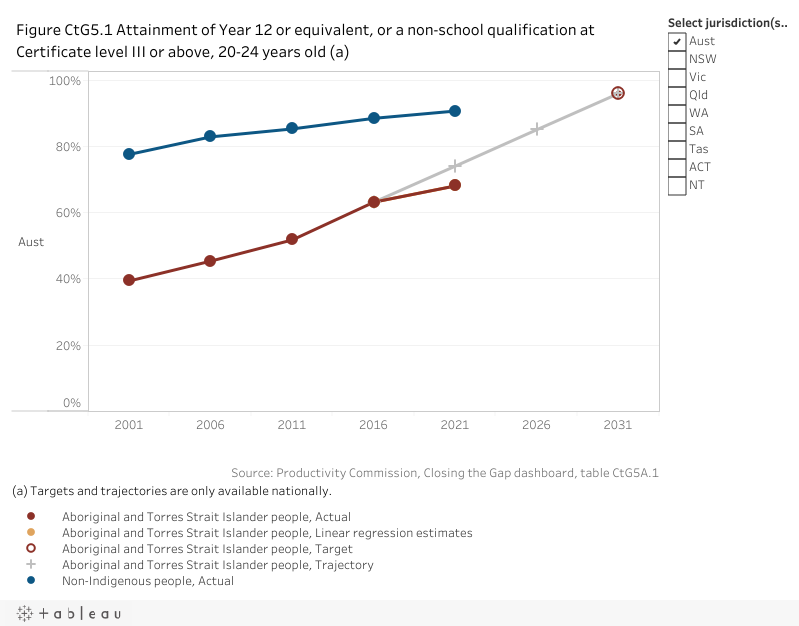
The assessment below reflects progress from the baseline (improvement, worsening or no change). For the national assessment, the target outcome shows improvement but is not on track to be met.
| NSW | Vic | Qld | WA | SA | Tas | ACT | NT | Aust | |
|---|---|---|---|---|---|---|---|---|---|
| Assessment of progress 2016 to 2021 |
improvement
no change
worsening not applicable as required data not available.
good improvement and target on track to be met.
improvement but target not on track to be met.
Note: These assessments of progress should be used with caution as they are based on a limited number of data points.
Disaggregations
Data tables appear under figures
By sex
Nationally in 2021, a higher proportion of Aboriginal and Torres Strait Islander females aged 20–24 years had attained Year 12 or equivalent qualification (71.7%) compared to males (64.5%) (figure CtG5.2). The proportions have increased by around seven percentage point for females and two percentage point for males since the 2016 baseline year.
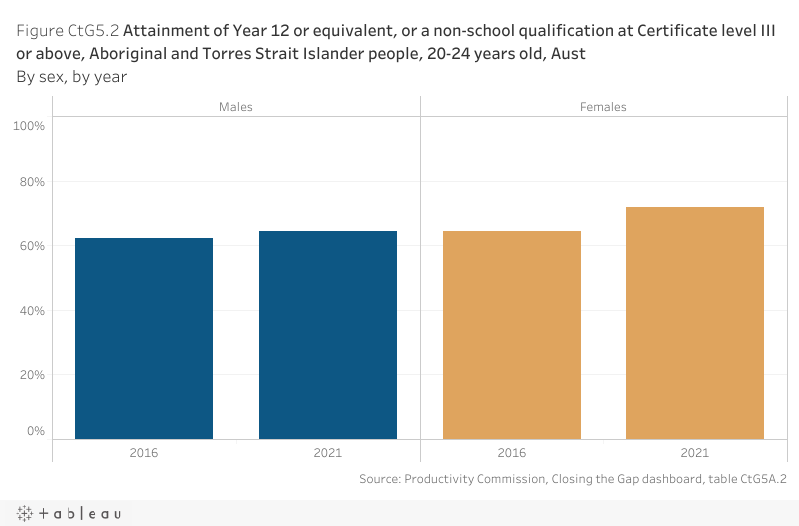
By remoteness area
Nationally in 2021, the proportion of Aboriginal and Torres Strait Islander people aged 20–24 years who have attained Year 12 or equivalent qualification was highest in major cities (75.9%) (figure CtG5.3). The proportions declined as remoteness increased, down to 41.7% for people living in very remote areas. The proportions have increased in all remoteness areas since the 2016 baseline year, though less so in very remote areas (less than one percentage point).
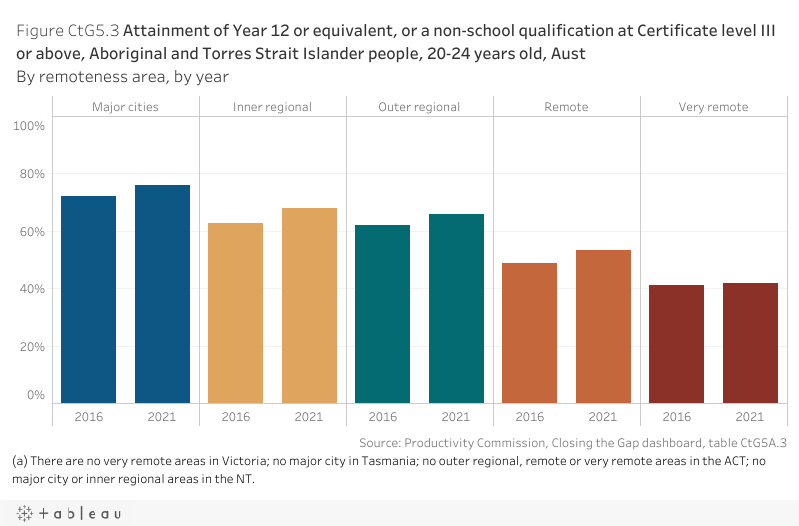
By Index of Relative Socio-economic Disadvantage (IRSD) quintile
Nationally in 2021, the proportion of Aboriginal and Torres Strait Islander people aged 20–24 years who have attained Year 12 or equivalent qualification was highest in the least disadvantaged socio‑economic areas of Australia (86.8%) (figure CtG5.4). The proportions declined in more disadvantaged areas, down to 57.7% for people living in the most disadvantaged socio‑economic areas of Australia. The proportions have increased in all socio‑economic areas since the 2016 baseline year.
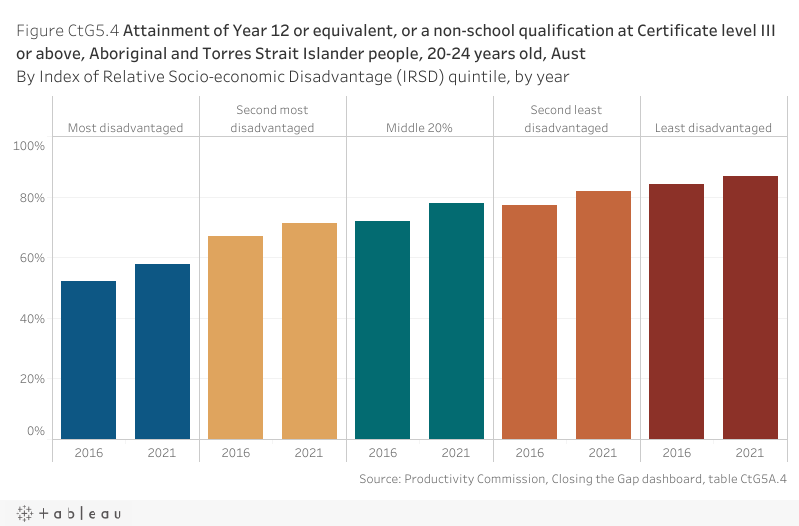
By disability status
Nationally in 2021, a lower proportion of Aboriginal and Torres Strait Islander people aged 20–24 years with a need for assistance with core activities had attained Year 12 or equivalent qualification (64.3%) compared to persons who do not have a need for assistance with core activities (69.6%) (figure CtG5.5). The proportion increased by around 11% for people with a need for assistance with core activities and six percentage point for people who do not have a need for assistance since the 2016 baseline year.
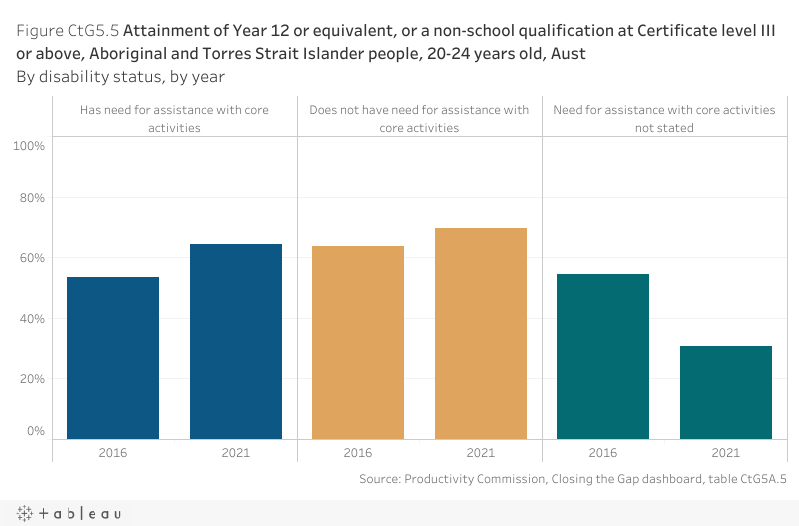
By attainment category
Nationally in 2021, the proportion of Aboriginal and Torres Strait Islander people aged 20–24 years who had attained Year 12 or equivalent qualification was mainly driven by people who had completed schooling at Year 12 or equivalent (59.5%, an increase of seven percentage point since the 2016 baseline), compared to people who had not completed school but had obtained a non-school qualification at Certificate III or above (8.6%, a decrease of around two percentage point since the 2016 baseline) (table CtG5A.6).
Target data specifications
Outcome: | Aboriginal and Torres Strait Islander students achieve their full learning potential. |
|---|---|
Target: | By 2031, increase the proportion of Aboriginal and Torres Strait Islander people (20–24 years old) attaining Year 12 or equivalent qualification to 96%. |
Indicator: | The proportion of Aboriginal and Torres Strait Islander people aged 20–24 years who have attained a minimum of Year 12 or equivalent, or Certificate level III or above qualification. |
Measure: | The measure is defined as: Numerator – number of Aboriginal and Torres Strait Islander people aged 20–24 years old who have attained a school qualification of Year 12 or equivalent, or a non‑school qualification at Certificate level III or above based on the Australian Qualifications Framework Denominator – total number of Aboriginal and Torres Strait Islander people in the population aged 20-24 years old and is presented as a percentage. |
Target established: | National Agreement on Closing the Gap July 2020 |
Latest dashboard update: | 15 June 2023 |
Indicator type: | Target |
Interpretation of change: | A high or increasing proportion is desirable. |
Data source(s): | Name: ABS Census of Population and Housing, Census Table Builder (Basic) Frequency: Five‑yearly Documentation (links): www.abs.gov.au/census |
Data provider: | Provider name: Australian Bureau of Statistics (ABS) Provider area: Census |
Baseline year: | 2016 |
Latest reporting period | 2021 |
Target year: | 2031 |
Disaggregations: | State and territory and Australia, by Indigenous status. State and territory and Australia, by Indigenous status, by sex. State and territory and Australia, by Indigenous status, by remoteness area. State and territory and Australia, by Indigenous status, by Index of Relative Socio‑economic Disadvantage (IRSD) quintile. State and territory and Australia, by Indigenous status, by disability status. State and territory and Australia, by Indigenous status, by attainment category. |
Computation: | Numerator divided by Denominator multiplied by 100. Counting rules The data is for all Australian residents enumerated in the Census that reported having a usual residence in Australia. Geographical variables are based on a person's place of usual residence (on Census night). Includes (numerator):
Includes (both numerator and denominator):
Excludes (numerator):
Excludes (both numerator and denominator):
Disaggregations: Sex refers to a person’s biological characteristics. The 2021 Census allowed all respondents to select from three response options for the sex question: male, female and non‑binary sex. Where a respondent has provided a male or female response and a non‑binary sex response, the male or female response was used to determine a binary sex variable. Otherwise, sex was derived by a statistical process using random allocation. Remoteness area is classified according to the ABS Australian Statistical Geography Standard (ASGS) using SA1 as the building block. For people with incomplete/invalid or missing address information, the ABS imputes the place of usual residence. The non‑response rate at the SA1 level was 4.4% in 2021. Remoteness area disaggregations exclude ‘Migratory – Offshore – Shipping’ and ‘No usual address’. Please see the How to interpret the data page for more information. Socio‑economic status of the locality is classified according to the Socio‑economic Indexes for Areas (SEIFA): Index of Relative Socio‑economic Disadvantage (IRSD) using SA1 as the building block. For people with incomplete/invalid or missing address information, the ABS will impute the place of usual residence. That data is reported by IRSD quintile, which is determined at the Australian level and excludes persons with unknown or unavailable SEIFA score. Some individual geographic areas were excluded from SEIFA for various reasons, such as low population or high non‑response to certain Census questions. Please see the How to interpret the data page for more information. Disability is classified according to core activity need for assistance. The data is only available for people with a profound or severe core activity limitation. Disability data sourced from the Census is based on four questions to identify need for assistance and may not be fully comparable with data from other sources. See www.abs.gov.au/ausstats/abs@.nsf/mf/4431.0.55.002 for more information. (Data for people whose ‘need for assistance with core activities’ was not stated is provided for context.) Attainment categories is classified according to Highest Year of School Completed. Extraction Census Table Builder (Basic) – Employment, Income and Education: INGP X YR12C3P (or HSCP X QALLP) X AGE5P X Main ASGS (UR) [Disaggregations: X SEX, X REMOTE (UR), X IRSD, X ASSNP, X HSCP]. |
Data quality considerations: | All data values have been randomly adjusted using perturbation to avoid the release of confidential data. Proportions/rates calculated for small populations should be used with caution. |
Supporting indicators
Driver
- School attendance
- School retention rates
- At or above National Assessment Program – Literacy and Numeracy (NAPLAN) minimum standards
In reading, writing and numeracy for years 3, 5, 7 and 9
- Mean scores of Aboriginal and Torres Strait Islander 15-year olds
In the Programme for International Student Assessment (PISA) test
Contextual information
- Mean score of NAPLAN reading, writing and numeracy for Years, 3, 5, 7 and 9
- Rates of highest education/training level completed
For those not completing Year 12 or equivalent
- Progress towards parity
Material for download
- Students achieve their full learning potential data tables (XLSX - 55 Kb)
- Students achieve their full learning potential dataset (CSV - 89 Kb)
To assist with interpretation of the data provided (Excel data tables and CSV dataset) please refer to the target data specification above.
